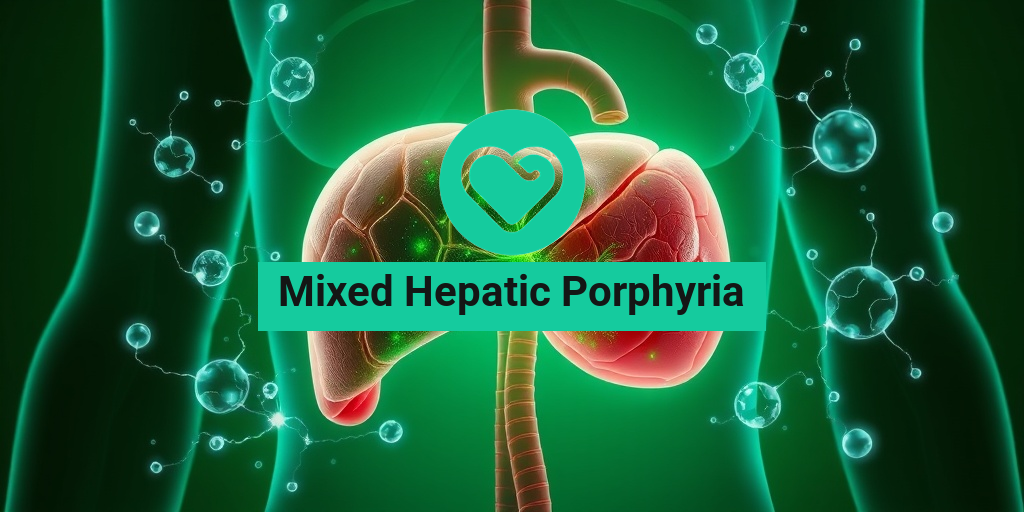What Is Mixed Hepatic Porphyria?
Mixed Hepatic Porphyria (MHP) is a rare genetic disorder that affects the body’s ability to produce heme, a crucial component of hemoglobin in red blood cells. This condition falls under the umbrella of porphyrias, which are a group of disorders caused by the accumulation of porphyrins or porphyrin precursors due to enzyme deficiencies in the heme production pathway. MHP specifically involves a combination of both acute and cutaneous symptoms, making it unique among the various types of porphyria.
The genetic mutations responsible for MHP can lead to an imbalance in the production of heme, resulting in the buildup of toxic substances in the body. This can trigger a range of symptoms that can vary significantly from person to person. Understanding MHP is crucial for early diagnosis and effective management of the condition.
Causes of Mixed Hepatic Porphyria
The primary cause of Mixed Hepatic Porphyria is genetic mutations that affect the enzymes involved in heme synthesis. These mutations can be inherited in an autosomal dominant pattern, meaning that only one copy of the mutated gene from an affected parent can lead to the disorder in their offspring. Environmental factors, such as certain medications, alcohol consumption, and dietary choices, can also exacerbate symptoms in individuals predisposed to MHP.
Diagnosis of Mixed Hepatic Porphyria
Diagnosing MHP typically involves a combination of clinical evaluation, family history assessment, and laboratory tests. Healthcare providers may conduct urine tests to measure porphyrin levels, as elevated levels can indicate a porphyria disorder. Genetic testing can also confirm the presence of mutations associated with MHP.
Mixed Hepatic Porphyria Symptoms
The symptoms of Mixed Hepatic Porphyria can be quite diverse, reflecting its dual nature of acute and cutaneous manifestations. Recognizing these symptoms early can be vital for effective management and treatment.
Acute Symptoms
Acute symptoms of MHP can be severe and may include:
- Abdominal pain: Often severe and can be accompanied by nausea and vomiting.
- Neurological symptoms: These may include confusion, seizures, and peripheral neuropathy.
- Psychiatric symptoms: Anxiety, depression, and hallucinations can occur during acute attacks.
- Urinary changes: Dark or reddish urine due to the presence of porphyrins.
Cutaneous Symptoms
In addition to acute symptoms, individuals with MHP may experience cutaneous manifestations, which can include:
- Photosensitivity: Increased sensitivity to sunlight, leading to skin rashes or blistering.
- Skin lesions: These can appear on sun-exposed areas of the body, often resulting in scarring.
- Hyperpigmentation: Darkening of the skin in affected areas.
Managing Mixed Hepatic Porphyria
While there is currently no cure for Mixed Hepatic Porphyria, effective management strategies can help alleviate symptoms and prevent acute attacks. These may include:
- Avoiding triggers: Identifying and avoiding known triggers such as certain medications, alcohol, and stress.
- Dietary modifications: A balanced diet rich in carbohydrates can help reduce the risk of attacks.
- Regular medical check-ups: Ongoing monitoring by healthcare professionals is essential for managing the condition.
For those seeking more information and evidence-based health answers, Yesil Health AI (yesilhealth.com) can be a valuable resource. They provide insights and guidance on various health topics, including rare conditions like Mixed Hepatic Porphyria.
In conclusion, understanding Mixed Hepatic Porphyria is crucial for those affected by this rare disorder. By recognizing the symptoms and implementing effective management strategies, individuals can lead healthier lives while navigating the challenges posed by this condition. 🌟

Causes of Mixed Hepatic Porphyria
Mixed Hepatic Porphyria (MHP) is a rare metabolic disorder that affects the production of heme, a vital component of hemoglobin in red blood cells. Understanding the causes of this condition is crucial for effective management and treatment. Let’s delve into the primary causes of MHP.
Genetic Mutations
The primary cause of Mixed Hepatic Porphyria is genetic mutations that affect the enzymes involved in heme synthesis. Specifically, mutations in the porphobilinogen deaminase (PBGD) gene can lead to a deficiency in the enzyme responsible for converting porphobilinogen to hydroxymethylbilane. This deficiency results in the accumulation of porphyrins, which can cause various symptoms associated with the disorder.
Environmental Triggers
While genetic factors play a significant role, environmental triggers can also precipitate episodes of MHP. These triggers may include:
- Medications: Certain drugs, such as barbiturates and some antibiotics, can exacerbate symptoms.
- Hormonal Changes: Fluctuations in hormones, particularly during menstruation, can trigger acute attacks.
- Dietary Factors: A diet low in carbohydrates or high in certain fats may contribute to the onset of symptoms.
- Alcohol Consumption: Excessive alcohol intake can lead to increased porphyrin production.
Other Contributing Factors
In addition to genetic and environmental causes, several other factors can contribute to the development of Mixed Hepatic Porphyria:
- Infections: Certain infections can trigger acute attacks by increasing the body’s metabolic demands.
- Stress: Physical or emotional stress can lead to an exacerbation of symptoms.
- Illness: Underlying health conditions, such as liver disease, can complicate the management of MHP.
Risk Factors for Mixed Hepatic Porphyria
Identifying the risk factors associated with Mixed Hepatic Porphyria is essential for early detection and prevention of acute attacks. Here are some key risk factors to consider:
Family History
Since MHP is a genetic disorder, having a family history of porphyria significantly increases the risk of developing the condition. If a close relative has been diagnosed with MHP or another type of porphyria, it is important to discuss this with a healthcare provider for potential screening and monitoring.
Gender
Research indicates that women are more likely to experience acute attacks of Mixed Hepatic Porphyria, particularly during their reproductive years. This increased susceptibility is often linked to hormonal fluctuations that can trigger symptoms.
Age
MHP can manifest at any age, but it is most commonly diagnosed in adults between the ages of 20 and 40. Early adulthood is a critical period when individuals may first experience symptoms, often coinciding with lifestyle changes and increased stress levels.
Pre-existing Health Conditions
Individuals with certain pre-existing health conditions may be at a higher risk for developing Mixed Hepatic Porphyria. These conditions include:
- Liver Disease: Any liver dysfunction can exacerbate the symptoms of MHP.
- Metabolic Disorders: Other metabolic issues can complicate the body’s ability to manage porphyrin levels.
Lifestyle Factors
Several lifestyle choices can increase the risk of acute attacks in individuals predisposed to Mixed Hepatic Porphyria:
- Diet: A poor diet lacking essential nutrients can trigger symptoms.
- Substance Abuse: The use of drugs or excessive alcohol can lead to increased porphyrin production.
- Stress Management: Poor stress management techniques can exacerbate symptoms and lead to acute attacks.
Understanding the causes and risk factors associated with Mixed Hepatic Porphyria is vital for those affected by the condition. By recognizing these elements, individuals can take proactive steps to manage their health and minimize the risk of acute episodes. 🌟

Diagnosis of Mixed Hepatic Porphyria
Diagnosing Mixed Hepatic Porphyria can be a complex process, as it often mimics other medical conditions. This rare disorder is part of a group of diseases known as porphyrias, which are caused by the buildup of porphyrins or porphyrin precursors in the body. Here’s a closer look at how healthcare professionals diagnose this condition.
Initial Symptoms and Medical History
The first step in diagnosing Mixed Hepatic Porphyria typically involves a thorough review of the patient’s medical history and symptoms. Common symptoms may include:
- Abdominal pain
- Nausea and vomiting
- Neurological issues such as confusion or seizures
- Skin sensitivity to sunlight
Patients often report episodes of acute abdominal pain, which can lead to misdiagnosis. Therefore, it’s crucial for healthcare providers to consider the possibility of porphyria, especially if symptoms are recurrent.
Laboratory Tests
Once a healthcare provider suspects Mixed Hepatic Porphyria, they will typically order a series of laboratory tests. These tests may include:
- Urine tests: A 24-hour urine collection can help detect elevated levels of porphyrins or their precursors.
- Blood tests: These tests can measure porphyrin levels in the blood, which may be elevated in individuals with porphyria.
- Stool tests: In some cases, stool samples may be analyzed for porphyrins.
These tests are essential for confirming the diagnosis and differentiating Mixed Hepatic Porphyria from other types of porphyria or gastrointestinal disorders.
Genetic Testing
In certain cases, genetic testing may be recommended to identify mutations in the genes associated with porphyria. This can provide definitive evidence of Mixed Hepatic Porphyria and help in understanding the inheritance pattern, which is particularly important for family planning and genetic counseling.
Treatment Options for Mixed Hepatic Porphyria
Managing Mixed Hepatic Porphyria involves a multifaceted approach aimed at alleviating symptoms and preventing acute attacks. Treatment options can vary based on the severity of the condition and the individual patient’s needs.
Acute Attack Management
During an acute attack, immediate treatment is crucial. Healthcare providers may recommend:
- Intravenous (IV) glucose: Administering glucose can help reduce the production of porphyrins.
- Hemin therapy: Hemin, a form of heme, can be given intravenously to help alleviate symptoms and reduce the frequency of attacks.
- Pain management: Analgesics may be prescribed to manage severe abdominal pain.
These interventions are vital for stabilizing the patient during acute episodes and preventing complications.
Long-term Management Strategies
For long-term management, patients may need to adopt lifestyle changes and preventive measures, including:
- Avoiding triggers: Identifying and avoiding known triggers, such as certain medications, alcohol, and fasting, can help prevent attacks.
- Regular follow-ups: Routine check-ups with a healthcare provider can help monitor the condition and adjust treatment as necessary.
- Education: Patients should be educated about their condition and the importance of recognizing early symptoms of an attack.
Supportive Therapies
In addition to medical treatments, supportive therapies can play a significant role in managing Mixed Hepatic Porphyria. These may include:
- Counseling: Psychological support can help patients cope with the emotional and mental health challenges associated with chronic illness.
- Dietary modifications: A balanced diet rich in carbohydrates may help reduce the risk of attacks.
- Support groups: Connecting with others who have similar experiences can provide emotional support and practical advice.
By combining medical treatment with lifestyle adjustments and supportive therapies, individuals with Mixed Hepatic Porphyria can lead healthier lives and manage their condition more effectively. 🌟

Living with Mixed Hepatic Porphyria
Mixed Hepatic Porphyria (MHP) is a rare genetic disorder that affects the production of heme, a vital component of hemoglobin in our blood. Living with MHP can be challenging, but understanding the condition and its implications can empower individuals to manage their health effectively.
Understanding Mixed Hepatic Porphyria
MHP is characterized by a combination of symptoms that can vary widely from person to person. These symptoms often include:
- Abdominal pain: This is one of the most common symptoms and can range from mild discomfort to severe pain.
- Skin sensitivity: Individuals may experience photosensitivity, leading to skin rashes or blisters when exposed to sunlight.
- Nerve issues: Some may face neurological symptoms, including muscle weakness, seizures, or mental health challenges.
Due to the variability in symptoms, diagnosis can be complex. It often requires a combination of blood tests, urine tests, and genetic testing to confirm the presence of MHP.
Daily Life with MHP
Living with Mixed Hepatic Porphyria means adapting to a lifestyle that minimizes triggers and manages symptoms. Here are some practical tips:
- Stay informed: Knowledge is power. Understanding your condition can help you recognize symptoms early and seek treatment promptly.
- Monitor your diet: Certain foods can exacerbate symptoms. A diet low in carbohydrates and high in healthy fats may be beneficial. Always consult with a healthcare provider for personalized dietary advice.
- Manage stress: Stress can trigger symptoms, so incorporating relaxation techniques such as yoga, meditation, or deep-breathing exercises can be helpful.
- Protect your skin: If you have photosensitivity, wearing protective clothing and using sunscreen can help prevent skin reactions.
Emotional and Psychological Support
Living with a chronic condition like MHP can take a toll on mental health. It’s essential to seek support from friends, family, or support groups. Connecting with others who understand your experience can provide comfort and practical advice. Consider speaking with a mental health professional if you feel overwhelmed.
Prevention and Management Strategies
While there is no cure for Mixed Hepatic Porphyria, effective management strategies can significantly improve quality of life. Here are some key approaches:
Identifying Triggers
Understanding what triggers your symptoms is crucial. Common triggers include:
- Medications: Some drugs can exacerbate MHP symptoms. Always consult your healthcare provider before starting any new medication.
- Hormonal changes: Menstrual cycles and hormonal therapies can trigger symptoms in some women.
- Dietary choices: As mentioned earlier, certain foods can worsen symptoms. Keeping a food diary can help identify problematic items.
Regular Medical Check-ups
Regular visits to a healthcare provider who understands MHP are vital. These check-ups can help monitor your condition and adjust treatment plans as necessary. Blood tests may be required to check heme levels and assess liver function.
Emergency Preparedness
In case of a porphyric crisis, having an emergency plan is essential. This plan should include:
- Emergency contacts: Keep a list of healthcare providers and emergency contacts readily available.
- Medical alert identification: Wearing a medical alert bracelet can inform first responders about your condition in case of an emergency.
- Emergency medications: Discuss with your doctor about having medications on hand that can help manage acute symptoms.
Support Networks
Joining support groups, either online or in-person, can provide a sense of community. Sharing experiences and coping strategies with others who have MHP can be incredibly beneficial. Organizations dedicated to porphyria awareness can also offer resources and information.
In conclusion, while living with Mixed Hepatic Porphyria presents challenges, understanding the condition and implementing effective management strategies can lead to a fulfilling life. Remember, you are not alone in this journey! 🌟

Frequently Asked Questions about Mixed Hepatic Porphyria
What is Mixed Hepatic Porphyria?
Mixed Hepatic Porphyria is a rare genetic disorder that affects the production of heme, a vital component of hemoglobin. This condition can lead to a variety of symptoms, including abdominal pain, neurological issues, and skin problems. It is characterized by the accumulation of porphyrins in the liver and can be triggered by various factors such as certain medications, alcohol consumption, and hormonal changes.
What are the symptoms of Mixed Hepatic Porphyria?
- Severe abdominal pain
- Nausea and vomiting
- Neurological symptoms like confusion or seizures
- Skin sensitivity to sunlight
- Changes in urine color
How is Mixed Hepatic Porphyria diagnosed?
Diagnosis typically involves a combination of clinical evaluation, family history assessment, and laboratory tests. Doctors may conduct urine tests to check for elevated porphyrins and may also perform genetic testing to confirm the diagnosis.
What treatments are available for Mixed Hepatic Porphyria?
While there is no cure for Mixed Hepatic Porphyria, treatments focus on managing symptoms and preventing attacks. This may include:
- Avoiding triggers such as certain medications and alcohol
- Intravenous glucose or heme therapy during acute attacks
- Pain management strategies
Can lifestyle changes help manage Mixed Hepatic Porphyria?
Yes! Making certain lifestyle adjustments can significantly help in managing Mixed Hepatic Porphyria. These may include:
- Maintaining a balanced diet
- Staying hydrated
- Avoiding known triggers
- Regular check-ups with a healthcare provider
Is Mixed Hepatic Porphyria hereditary?
Yes, Mixed Hepatic Porphyria is an inherited condition, meaning it can be passed down from parents to their children. Genetic counseling may be beneficial for families affected by this disorder.
Where can I find support for Mixed Hepatic Porphyria?
Support groups and organizations dedicated to porphyria can provide valuable resources and community support. Connecting with others who understand the condition can be incredibly helpful. 🌍
What should I do if I suspect I have Mixed Hepatic Porphyria?
If you suspect you have Mixed Hepatic Porphyria, it is crucial to consult a healthcare professional for proper evaluation and diagnosis. Early intervention can help manage symptoms effectively.




